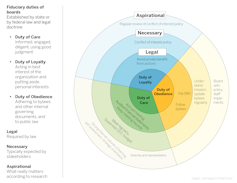What nonprofit boards need to do to protect the public interest
- Written by Beth Gazley, Professor of Public and Environmental Affairs, Indiana University
 The best boards meet often.Thomas Barwick/DigitalVision via Getty Images
The best boards meet often.Thomas Barwick/DigitalVision via Getty ImagesThe people who serve on a nonprofit’s board of directors are legally responsible for its performance. Despite their importance, board members are rarely in the news. When they do make headlines, they may have messed up.
Perhaps the most spectacular example is what happened to Donald Trump’s now-defunct charity. While he was a sitting president, Trump was forced to dissolve his foundation and pay US$2 million to other causes after New York state authorities found that the Trump Foundation had violated numerous state and federal laws.
Among other lapses, his foundation inappropriately coordinated with his political campaign and engaged in self-dealing – using charitable money for his own personal benefit. In addition, state authorities determined that the foundation’s board members had failed to fulfill their duties.
In fact, that board allegedly hadn’t even held a meeting for two decades.
Fortunately, such cases are rare. But as a nonprofit management professor, I find that extreme tales of board failure can help illustrate what boards are actually supposed to do and why it’s so important to get it right. Public trust in charities is at stake.
Doing more than the minimum
To perform their jobs at a minimal level, boards of directors have to meet legal requirements, such as convening at least once a year and supervising an organization’s top leader.
But board members must do more than that if they are to meet the expectations of the donors, volunteers, staff and other stakeholders of the nonprofit they oversee. Let’s call these the “necessary” versus the “legal” obligations. While nonprofits’ tax-exempt status requires them to show the public they perform some community benefit, stakeholders who are supporting the organization may demand more.
Fortunately, board members can turn to organizations like the Council of Nonprofits and other sources trusted by experts for excellent guidance. Let’s take these expectations one by one.
The basics
Most states require nonprofit boards to include at least one to three people. Experts believe that groups make better decisions than individual people.
So donors are wise to insist that any charity they fund have more board members than the minimum for better oversight. Larger boards – but not too large – perform better. Most have somewhere between eight and 14 members; newer organizations may have fewer.
 Nonprofit boards that do more than the law requires are more likely to succeed.Beth Gazley and Colin Kulpa, CC BY-NC-SA
Nonprofit boards that do more than the law requires are more likely to succeed.Beth Gazley and Colin Kulpa, CC BY-NC-SAThere are an estimated 1.5 million registered nonprofits in the U.S., with staffs that may range from a single unpaid founder to thousands of employees. These groups carry out a dizzying array of missions, ranging from community health care to boosting support for national parks.
Because of that diversity, experts will never agree on a single job description for nonprofit board members. Nor would they agree on a single recipe for who should sit on a board, although experts think nonprofits should pay more attention to diversity and representation.
Nonprofit boards typically recruit people who can represent the people served and who bring a range of skills and expertise in such areas as finance, communications and management, along with a connection to the organization’s mission. Most nonprofits also expect board members to make a meaningful financial contribution to the organization themselves.
Although it’s legal for nonprofits to pay board members, most are volunteers.
Care, duty and obedience
Legal expectations of boards come from both the states and the federal government. For the most part, a board’s legal responsibilities fall into three categories: a duty of care, a duty of loyalty and a duty of obedience.
Care means board members must meet regularly enough and provide enough oversight to ensure a nonprofit’s staff, budget and other resources are furthering the mission rather than squandering its funds or diverting them into personal expenditures.
Loyalty means they must act in the organization’s best interest, rather than their own, avoiding conflicts of interest.
Obedience has to do with ensuring that the group follows all applicable laws and regulations while acting in accordance with its own policies and mission.
Those three obligations add up to what’s known as a board’s fiduciary duties.
These duties encompass most of what boards do: approve budgets and expenditures; ensure that audits are conducted; hire the nonprofit’s chief executive and set that person’s compensation; and ensure that required public reporting happens, such as submitting a 990 information return to the Internal Revenue Service every year.
Nonprofit board members have many legal obligations.Nobody’s business
Unlike in the case of businesses, nobody owns a nonprofit.
Instead, nonprofits essentially belong to themselves. Since they are mostly tax-exempt, they operate under the distant supervision of public officials such as a state’s attorney general. The board acts as agent of the state to ensure the public trust is not broken.
That’s why board members are often called “trustees.”
And on the rare occasions when that trust is broken, state officials will exercise their authority to step in, as they did with the Trump Foundation.
States set minimal standards for what boards need to do. Often, minimal compliance with those regulations does not suffice for an organization to thrive. For example, most states require boards to meet at least once every year.
Yet most boards meet five to eight times per year, since nonprofit experts agree that multiple meetings are needed to keep board members sufficiently informed and engaged. Additionally, regulators don’t require a conflict-of-interest policy, but stakeholders would be wise to do so.
Board cultures
A board’s structure – how big it is and how often it meets – is fairly easy to observe and measure. But what matters more is how the board behaves. How boards do their work is at least as important as what they do.
I’ve identified three kinds of cultures that help a board stay focused on what matters: a culture of learning, a culture of assessment and a strategic culture.
First, boards have to be willing to learn how to govern well, such as through training themselves. One common practice is an orientation for new members.
Members also need to assess not only the organization’s financial health but the health of the board itself. Although a board self-assessment is a recommended practice, since it ensures board members understand their job, it is practiced by only 4 out of 10 nonprofits.
Finally, boards need to devote sufficient time to planning for the nonprofit’s future. Strategic boards that do this may in turn support organizations that are more resilient – such as those that can withstand crises like the COVID-19 pandemic.
As for who can serve on a board, the honest answer is that just about any adult can. I would encourage anyone who is passionate and knowledgeable about a cause to look for leadership opportunities on a nonprofit board. If you have children enrolled at a school, how about becoming a member of its PTA board? If you enjoy shopping for fresh produce, perhaps you can join a board that manages your local farmers market.
Just be ready for the legal responsibility of being a trustee.
Beth Gazley receives funding from no organizations referenced in this article
Authors: Beth Gazley, Professor of Public and Environmental Affairs, Indiana University
Read more https://theconversation.com/what-nonprofit-boards-need-to-do-to-protect-the-public-interest-188966

